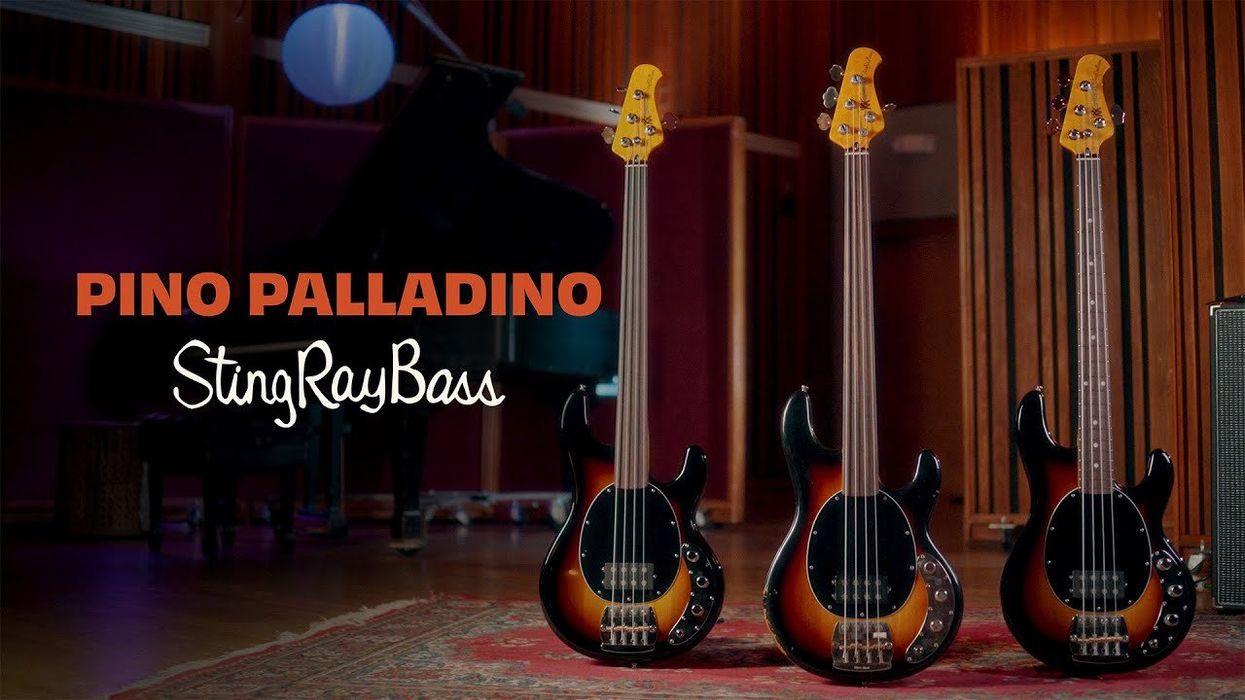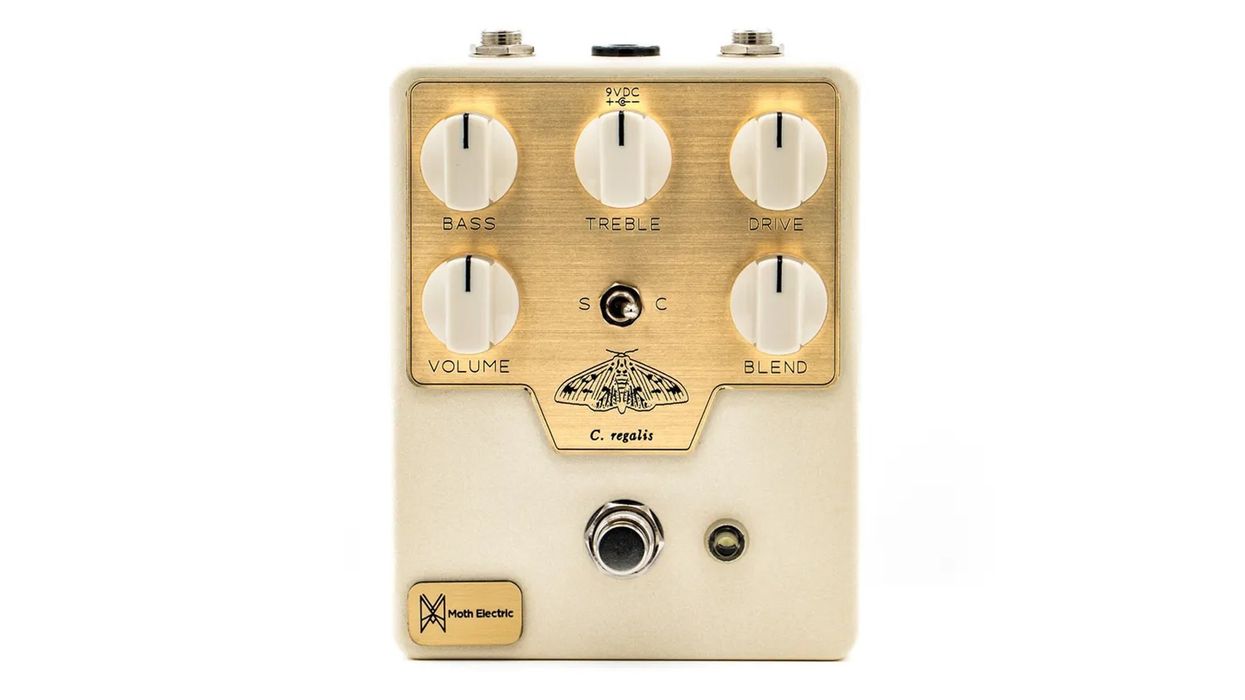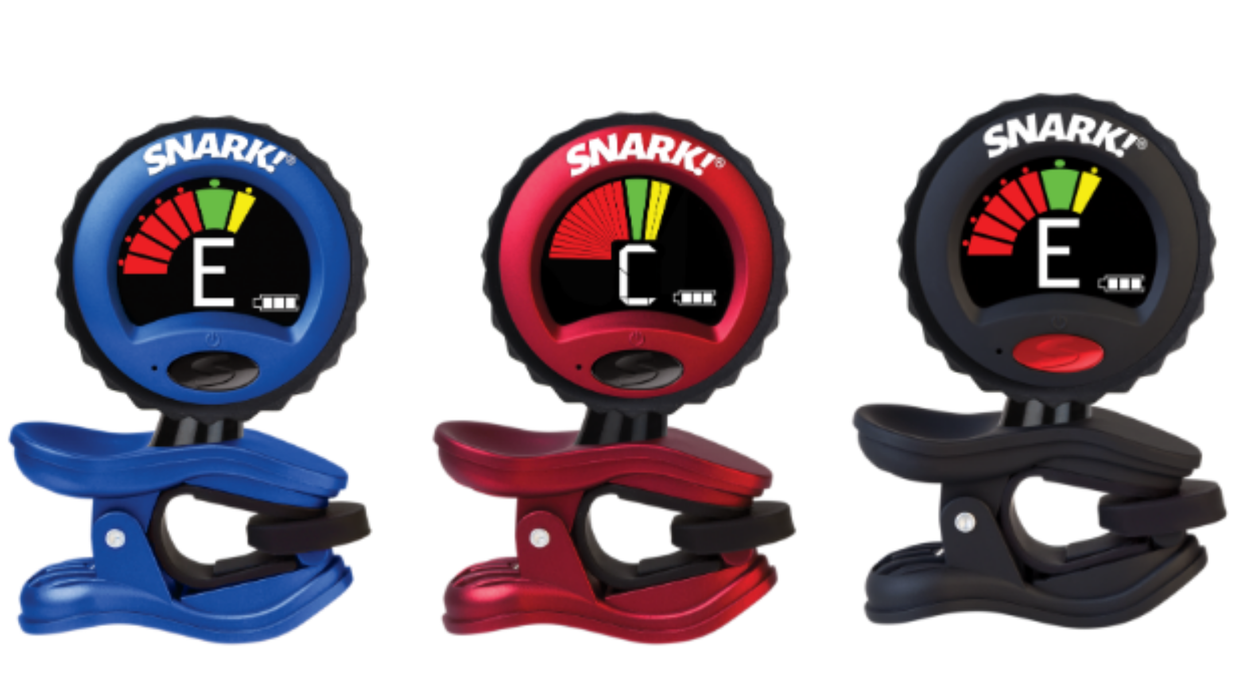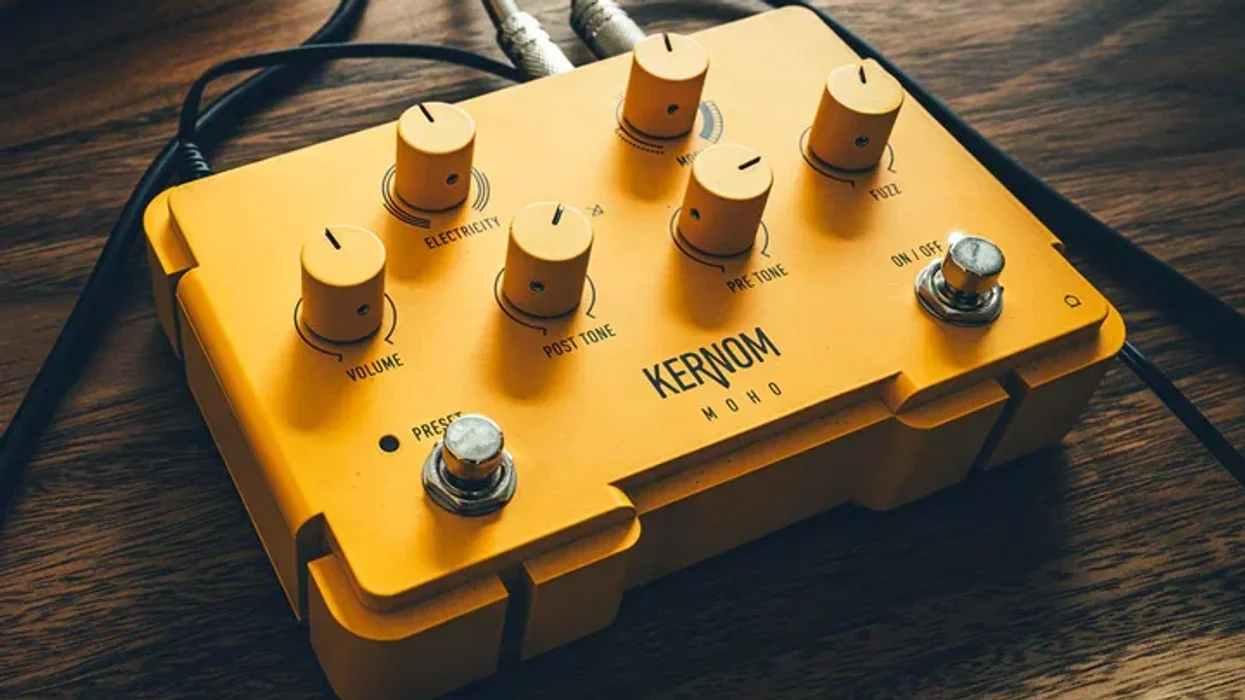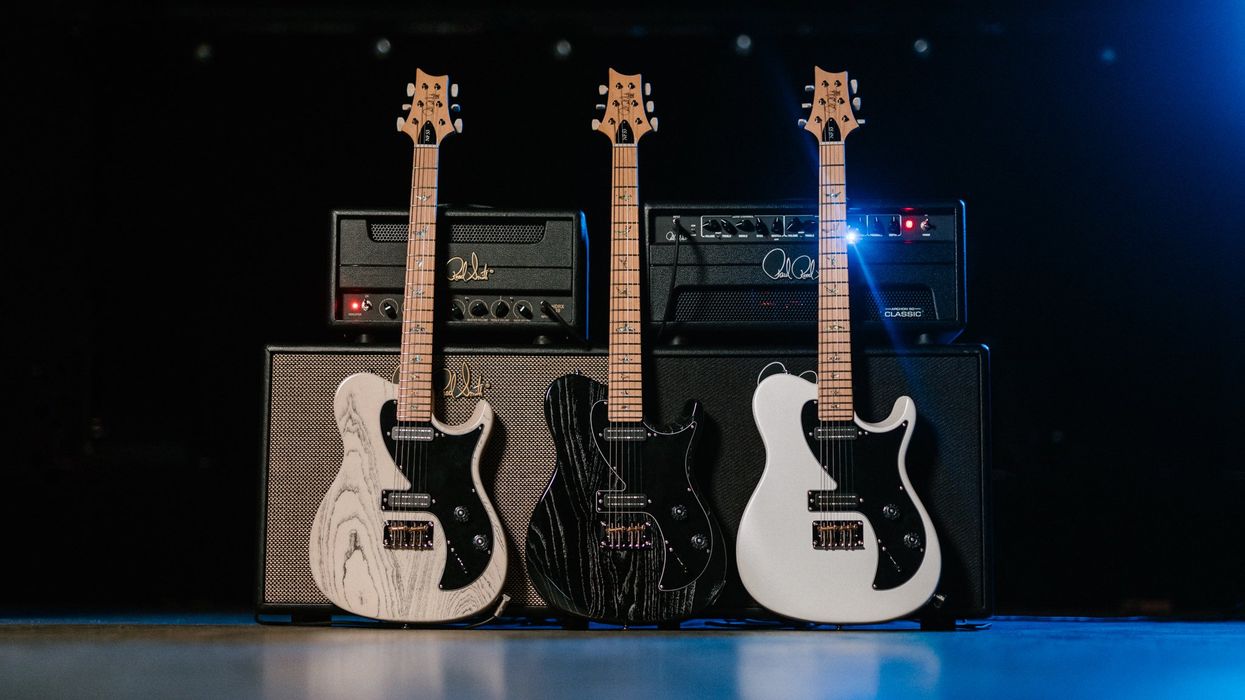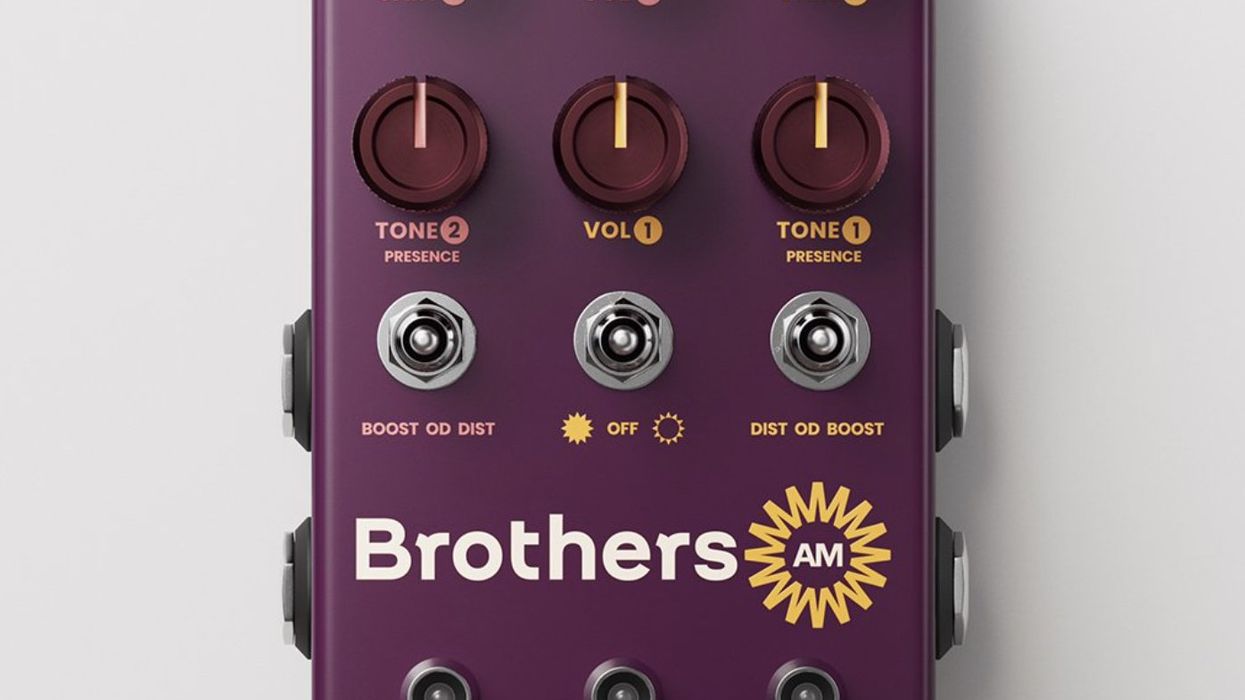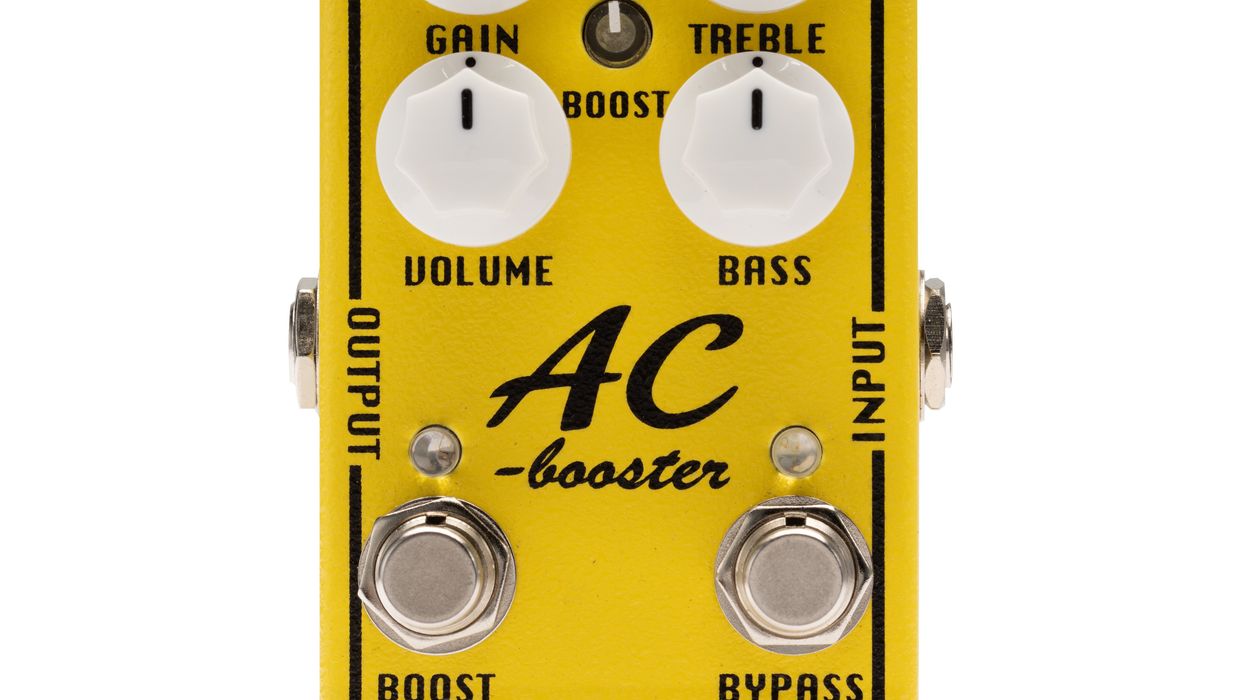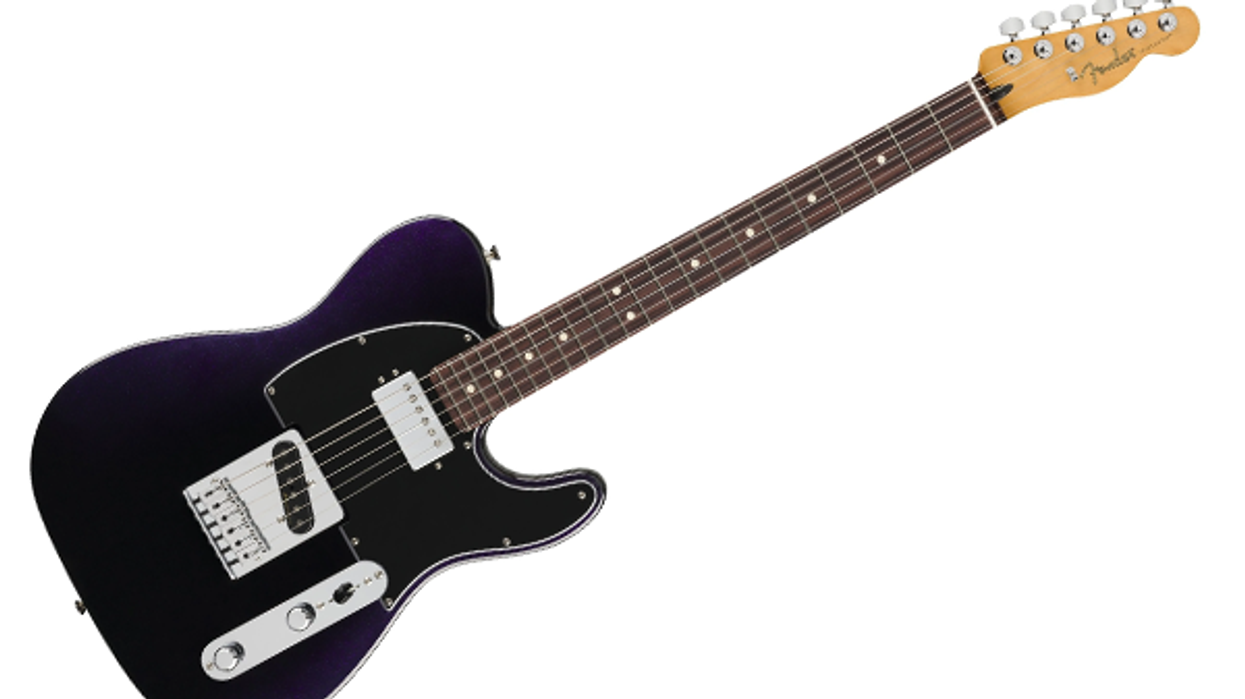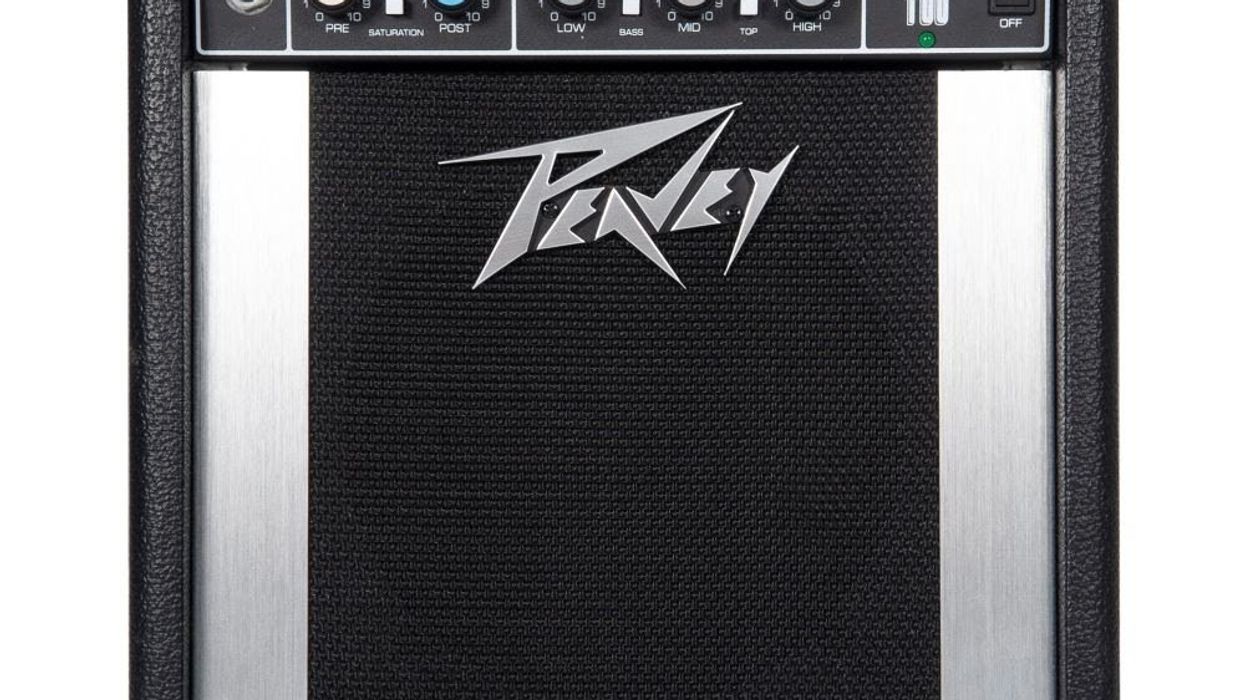Like so many of the delicious twists in the history of innovations, the dreadnought acoustic is the product of fate, unexpected convergences, and a great idea. But it’s also true that the most popular guitar design in the world could have just as easily faded into obscurity—or never happened at all.
In the beginning, the notion of a dreadnought wasn’t even a dusty rattle in the halls of Martin’s Nazareth, Pennsylvania, headquarters. The concept—if not all the engineering know-how—was the brainchild of the Oliver Ditson Company, which operated music stores in Boston and New York. Ditson wanted to satisfy the clamor from dance-band guitarists desperate for more volume, so the company approached Martin about making their design idea reality. In 1916, the first dreadnought—a slotted-headstock, 12-fret instrument bearing the Ditson brand—made its debut. But the strangest part of the story is that Martin remained skeptical, or least relatively indifferent to the to the guitar’s potential, for years afterward. There wasn’t a dreadnought with the Martin name until 1931, and the 14-fret version we know and recognize today didn’t see the light of day until 1934. Needless to say, the gang at Oliver Ditson was on to something. By the late ’30s, the dreadnought was one of Martin’s most successful instruments. And in the decades to come, artists from Gene Autry and Bill Monroe to Neil Young and Jimmy Page would help make the dreadnought among the most popular and ubiquitous musical instruments in the world.
The five dreadnoughts reviewed here are all still very much the children of that first Martin-built Ditson. And their sonic merits, while varied, are rooted in the same qualities sought in that very first model—volume, projection, and authority. Of course, there’s a lot more to a dread than sounding big, and one of the coolest things about the five dreads profiled here—which can all be had for between $750 and a grand—is the range of feel and tone color among them.
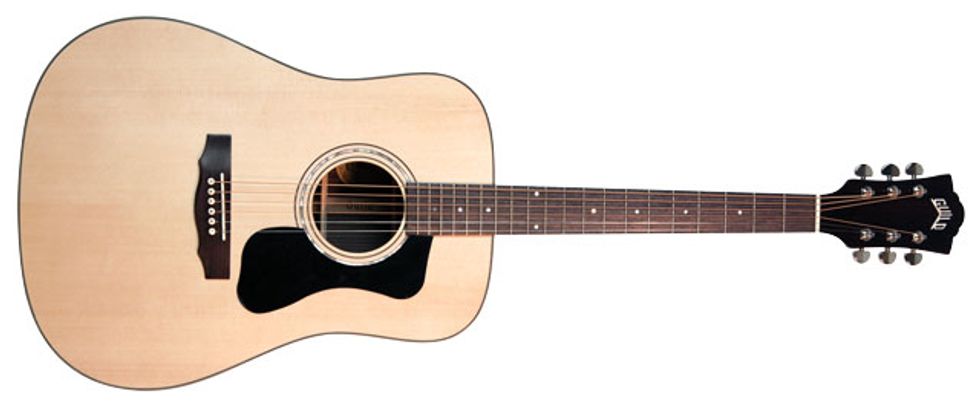
Guild D-150
Guild built its first dreadnoughts in the
early ’60s—just in time for a cultural
earthquake that would find half the kids
in America clamoring for a 6-string.
Fortunately for Guild, the company nailed
its first attempts. The mahogany-and-spruce
D-40 and rosewood-and-spruce D-50 were
beautiful, well-built, and balanced guitars,
and they became fixtures on the ’60s folk
and rock scenes. The D-150 reviewed here
is a Chinese-built interpretation of the
legendary D-50, and it does a noble job of
delivering on the sonic promise of the D-50
at a more accessible price.
At a fast glance, you’d be hard-pressed to tell the difference between the D-150 and its US-built brother. The D-150 has a black pickguard instead of the D-50’s faux tortoiseshell guard, and the D-150’s bridge is rosewood rather than ebony. The D-150 also lacks some fancy touches, like a headstock inlay. Overall, though, the D-150 is a carefully crafted guitar. Bracing and kerfing are all tidy and relatively clean, save for a few very small glue smudges on the back bracing. There’s also some uneven finish work at the end of the fretboard closest to the soundhole. The materials all have the look of first-rate stuff, however. The solid rosewood on the back and sides is dark and rich in appearance, and the spruce top has a tight, even grain pattern. A motherof- pearl rosette adds a deluxe touch to the Guild’s otherwise streamlined and elegant outward demeanor.
Ratings
Pros:
great midrange projection and headroom
for loud strumming and picking. nice materials.
Cons:
lacks just a little on the bottom end.
sounds a little stiff at times.
Tones:
Playability/Ease of Use:
Build:
Value:
Street:
$750
Guild Guitars
guildguitars.com
The D-150 feels great in hand. The satin-finished mahogany neck, 1.68" string spacing at the nut, and medium action combine to make barre chords feel natural and easy right up to the 12th fret, although slightly lower action might make the guitar a little better suited for bluegrass and country flatpicking and fingerstyle. However, for heavy strumming, folk arpeggios, and deepdigging blues lines, the guitar still feels very responsive and dynamic.
Sonically speaking, the D-150 fills all the traditional dreadnoughts roles very well. It’s a big-sounding guitar when you strum with a heavy flatpick, with a ton of headroom for Townshend-style aggression, and a loud, warm, full-spectrum tone that kicks with low-mid and midrange content that gives single-note solos a cutting and authoritative voice. If the D-150 lacks anything, it’s the truly robust low end that a lot of players look for in a dread. However, getting it may just be a matter of being patient, for there’s a pronounced new-guitar stiffness in the D-150 that suggests it will open up and breathe as it ages—as is often the case with all solidwood acoustics.
With just enough finery to make it feel special, and a design restraint that enhances the beautiful balance of body lines, the D-150 is a very complete dread. Fast flatpickers will long for lower action, though the guitar as it’s set up here makes it a great vehicle for heavier Neil Young-style strumming. And at right around $750 on the street, it’s a great way to get a well-rounded and, at times, refined dread for a fair price.
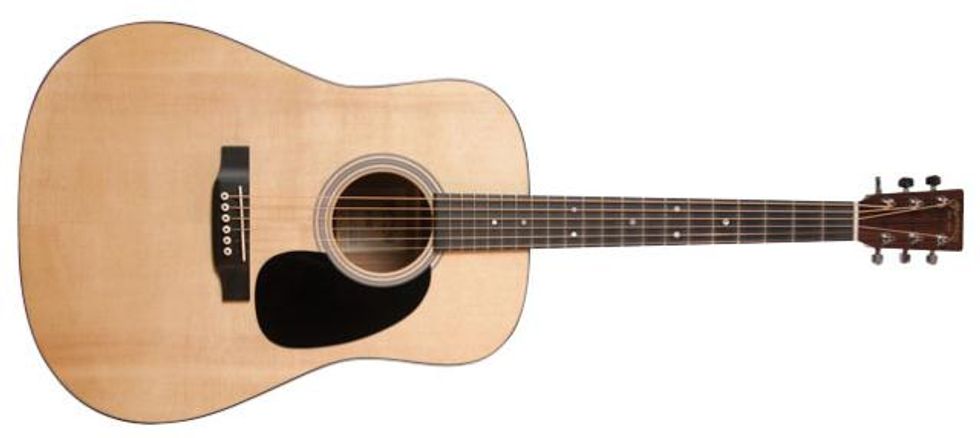
Martin D-1GT
Martin built the very first dreadnought,
not to mention the most priceless and collectible
specimens of the form. The venerable
D-18 and D-28 practically define the
model, so it’s barely going out on a limb to
say that the crew from Nazareth can probably
build a dread in its sleep.
Perhaps the only complaint ever leveled against a classic Martin dread like a D-28 is that they can be a bit pricey. But Martin has always strived to make accessibly priced instruments, too, and the D-1GT reviewed here is the product of the company’s strategy to make an American-made Martin with a solid spruce top and solid back and sides available to working players for less than a thousand bucks. And while Martin makes the D-1GT affordable through use of some nontraditional materials—most notably the Stratabond laminate neck and Richlite fretboard—this is a Martin through and through, in terms of quality, and a truly distinctive one in terms of sound.
While there are more bare-bones dreadnoughts out there—even within Martin’s line—the D-1GT is pretty austere. The D-28-style rosette is its flashiest aspect, but apart from that, the satin-finished sapele back and sides, the black pickguard, and the minimalist black-white-black binding give the guitar a no-nonsense, back-to-basics attitude.
Ratings
Pros:
Beautiful, balanced tone and projection.
very touch responsive. great sustain.
Cons:
Stratobond neck can feel slightly rough
and irregular to the touch.
Tones:
Playability/Ease of Use:
Build:
Value:
Street:
$899
Martin
martinguitar.com
The texture of the Stratabond neck can take some getting used to, though: In some spots the neck feels like a regular satin-finished solidwood neck, there are spots where you can ever-so-slightly feel the texture of the laminate. Over hours of playing these necks can come to feel smoother, but the neck can feel a bit unfinished if you’re accustomed to a glossy-finished neck. That issue aside, the oval-profile neck with its 1 11/16" string spacing (at the nut) feels super comfortable and easy to navigate, and the Richlite fretboard rarely feels significantly different than a hardwood fretboard.
If you were ever confused about the term “piano-like” in the context of a guitar review, the D-1GT can go a long way toward clarifying things. Certainly there are guitars that are much more deep and grand in their pianistic ways than the D-1GT, but this Martin has a touch sensitivity, responsiveness to dynamics, and dry but harmonically resplendent resonance that is most certainly worthy of the term. The sapele back and sides (sapele shares many tone properties with mahogany) may limit the headroom on the D-1GT, and really heavy strumming will yield a hint of harmonic blur on top of essentially strong and clear fundamental tones—a quality that’s not uncommon among sapele- and mahoganybacked instruments. The guitar also tends toward a strong, airy midrange that’s absolutely beautiful in open tunings and capoed voicings that generate droning mid and high-mid content. Bluegrass players and more aggressive fingerstylists that like to generate a little more bottom-end thump, may end up longing for the greater definition you can get from rosewood back and sides. But, that trade-off aside, the D-1GT is superbly balanced and an ideal partner for roots rock, nimble fingerstyle in open tunings, and country blues that benefits from a warm, husky tone.
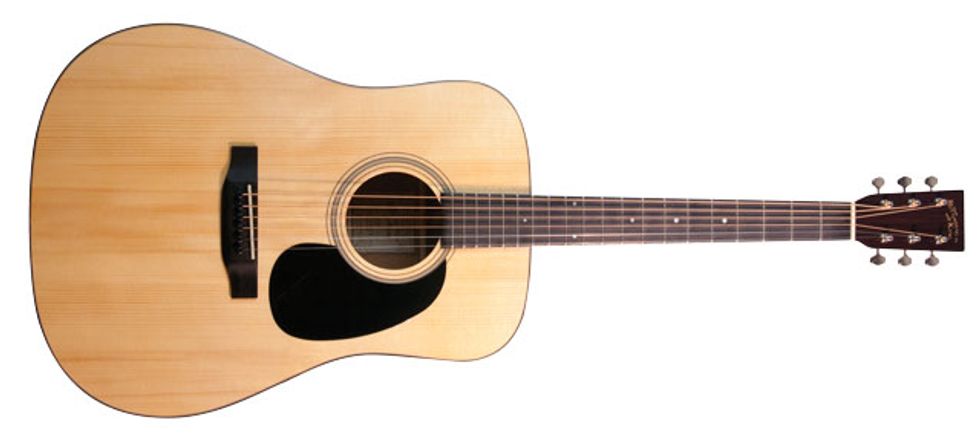
Recording King RD-316
Recording King has existed as a brand, on
and off, since the early 20th century, when it
was a Montgomery Ward house brand used
to ply rebadged Gibsons. In the last decade,
the brand was resurrected by The Music
Link—primarily as a vehicle for selling the
company’s line of excellent and affordable,
Chinese-built, mid-century-styled acoustics.
But while the Recording King brand has
a history all its own, everything from the
headstock and bridge shape to the rosette
and tonewoods in the new RD-316 model
leaves little doubt about the extent to which
Martin’s iconic D-18 is an influence.
One of the most significant differences between the Recording King RD-316 and a gazillion other contemporary D-18 imitations, however, is the guitar’s use of Adirondack spruce for the top. Adirondack was the top wood Martin used for its most iconic dreads from the ’30s through the postwar golden age. And it’s still treasured by luthiers for its fast response, high volume ceiling, and full-spectrum tone. On the Recording King, it also adds a cool visual air: The Adirondack top is wide grained and striking—lending an almost fingerprint-like individuality to the guitar. And it’s worth noting that, while finicky customers tend to drive luthiers large and small to use narrow-grained spruce because of its tidy visual uniformity, a lot of guitar builders insist that it’s this wider-grained stuff that sounds the sweetest.
Recording King didn’t stop at the use of Adirondack to make the RD-316 vintage correct. The one-piece mahogany neck has a headstock volute, and the headstock itself is bedecked with open-back Grover butterbean tuners. The guitar is finished in period- correct nitrocellulose, the fretboard and bridge are ebony, and the nut and saddle are all bone—just like a mid-century D-18.
Ratings
Pros:
vintagecorrect
specs and
vibe galore. Fantastic
dynamic range.
Cons:
workmanship could
use a little more Tlc
in several spots.
Tones:
Playability/Ease of Use:
Build:
Value:
Street:
$799
Recording King
recordingking.com
Though the materials that go into the RD-316 are all superb, there are some places where the workmanship leaves a little to be desired. The finish is uneven where the fretboard and soundhole meet, running from a bit too thick to almost absent. The edge of the fretboard is a little rough between the fourth and ninth frets, and certain spots on the bracing and kerfing are marred by rough cuts that could use some simple sanding. Fortunately, none of these shortcomings have much to do with how the guitar sounds or plays.
The Recording King’s neck is a pleasure to cradle and feels friendly, fast, and familiar— especially if you’ve ever had the chance to play a postwar Martin from the ’40s or ’50s. It has a substantial D profile, yet manages to feel compact and easy to navigate. And like any classic Martin D series, it has a flatpicker-friendly 1 11/16" string spacing at the nut that makes fast picking and chording a breeze. Playbility could arguably benefit from slightly lower action, though the medium action that we received the guitar with is great for heavy-handed strumming and deep blues bends.
Adirondack spruce is, in large part, about dynamic range, and the RD-316 has acres of it. Strumming a simple D chord, you can move from a nuanced, whisper-soft arpeggio to a vigorous strumming onslaught without any perceptible loss of harmonic detail. And the projection and volume that you can summon from the guitar is nothing short of impressive. Tonally speaking, the guitar at times seems to inhabit an interesting middle ground between the traditional warmth of mahogany and the snap and projection of rosewood, particularly when you’re strumming with a vengeance. More languid and melodic picking tends to coax out the mahogany flavor, however, and fingerstylists and country blues pickers will savor the RD-316’s combination of dry, husky midrange honk, mahogany glow, and sustain.
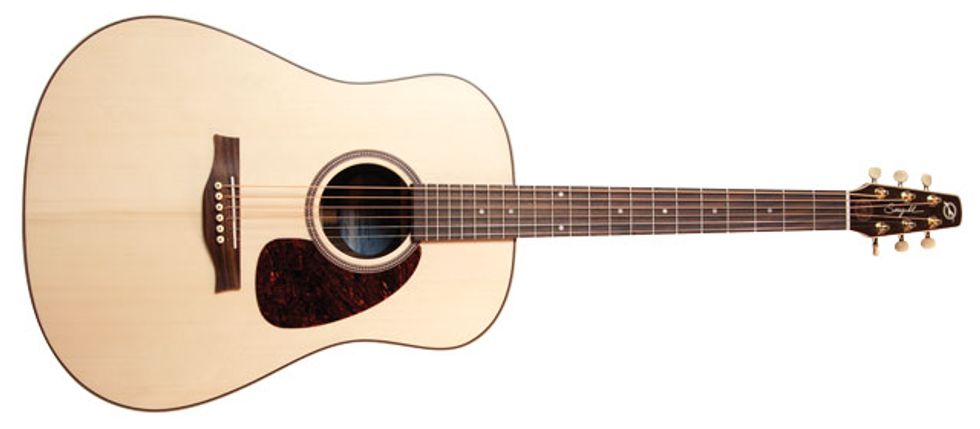
Seagull Maritime
SWS Rosewood SG
Quebecois have a knack for putting a
unique twist on just about everything. The
province, its people, and culture manage
to be Canadian, French, American, and
English all at once—making it a place of
very unique style. So it goes when it comes
to building guitars, too. Seagull—a division
of Godin Guitars in Quebec—has
always been very willing to impart this
design individuality on its guitars, too,
fusing forward-looking design elements
with traditional materials. The Maritime
SWS (Solidwood Series) Rosewood SG
is no exception. Its most overt deviation
from tradition is the Seagull headstock—a
slender, tapering affair that yields straighter
pull across the nut that can result in greater
tuning stability and resonance. A more
subtle design variation can be seen in the
Maritime’s curvaceous body profile, which
uses a slope shoulder not unlike a Gibson
J-45, and a waistline that’s shifted a little
further forward than the classic Martin
profile. It’s a beautifully balanced design
and a refreshing twist on a classic shape.
Ratings
Pros:
very nice tonal balance. singing midrange. great
low-end growl. nice craftsmanship and materials. loud!
Cons:
may not have enough low-end thump for some
flatpickers.
Tones:
Playability/Ease of Use:
Build:
Value:
Street:
$799
Seagull
seagullguitars.com
The Seagull is the only entirely satin-/ semi-gloss-finished guitar in our test group. Interestingly, the semi-gloss finish almost makes the Seagull feel more luxurious— highlighting both the quality of materials and the flawless construction on the exterior of the body. The solid spruce top’s grain pattern is mostly tight, but there are cool little grain patterns, too, and the solid rosewood back and sides lend the feel of a fine piece of furniture. Other stylish touches include a rosewood bridge, gold tuners, and crème-colored, almost-Bakelite-textured plastic tuning keys.
The 3-piece mahogany neck is shaped in a variation on the classic, flat-ish, thin C profile you see on other Godin-built guitars, such as those from Simon & Patrick and Arts & Lutherie. It’s an interesting and ultimately very comfortable and playable neck that feels like a hybrid between a classical neck and an OM—though in this case, the nut width is a narrower, more flatpicking-friendly 1.72".
Of all of our test guitars, the Seagull might have the most even and wellrounded voice. The midrange is beautifully airy and chiming, and the bottom end, while not booming, is a perfect, throaty complement to the sparking midrange and trebles—it makes the guitar growl when you tune the bottom string down a step or two. The Seagull also has a delightfully high volume ceiling. You can attack the strings as hard as you want without inducing any pronounced harmonic blur, and the rosewood back helps ensure the Seagull is loud. In fact, it’s hard to imagine being outgunned around a campfire jam with this guitar in hand.
Thanks to the Seagull’s superb tonal balance, neck profile, and responsiveness, it’s an exceptional fingerstyle dread, too. The same balance makes it a first-rate chord machine for rhythm work and vocal accompaniment. It may not have quite as much punch for single-note, bluegrass picking as some of the other dreads in our roundup, but given the Seagull’s agreeable tone palette and versatility, that’s a minor shortcoming.
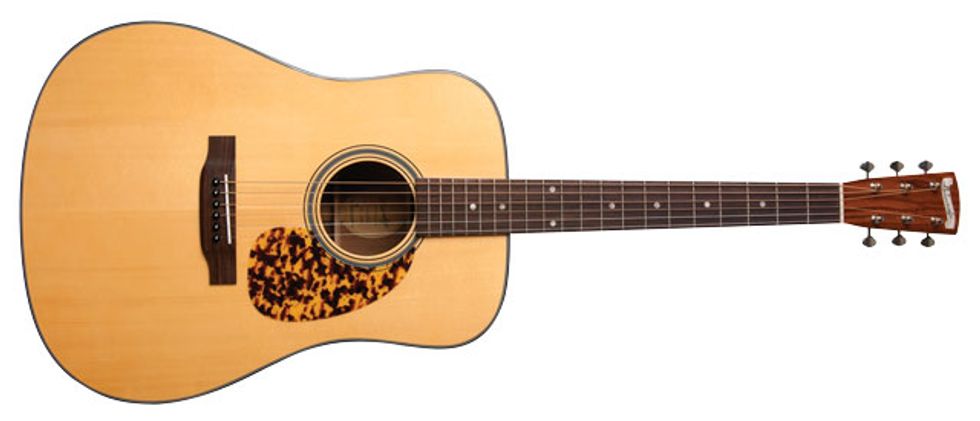
Blueridge BR-140A
Blueridge’s, ahem, blueprint for success
is one that’s hard to argue with: Take
classic American designs, top-quality
materials, and an offshore factory that
can do quality work for less, and build
guitars that absolutely kill for their price
range. That formula is one that’s made
Blueridge, a division of Saga Instruments,
a go-to brand for serious guitarists who
can’t spend big bucks for a mid-century
American classic or reissue.
In the case of the BR-140A, Blueridge is out to win the hearts of Martin D-18 lovers who can’t sell the family car for a Martin version. Like the Recording King RD-316 also reviewed here, the BR-140A takes an extra step toward authenticity through use of Adirondack spruce as a top wood, which lends the guitar a more vintage-flavored sonic signature as well.
Ratings
Pros:
distinctive blend of vintage-correct and unique
styling elements. warm,
balanced tone and wider
string spacing make it
fingerstyle friendly.
Cons:
lacks the volume traditionally
associated with
an adirondacktopped
dread.
Tones:
Playability/Ease of Use:
Build:
Value:
Street:
$779
Blueridge
sagamusic.com
Like the D-18 that inspired it, The BR-140A gracefully walks the line between luxury and economy of design. The flashiest part of the guitar is the signature Blueridge Dalmatian faux-tortoise pickguard (a not-quite-vintage-correct touch that conjures images of Prince’s legendary Hohner T-style in the very best way). But elsewhere, the Blueridge embraces the D-18’s recipe for elegance with great reverence and restraint. The back and sides are a beautiful reddish mahogany, with a rather deep and striking grain. The top is a distinct mixture of wide and fine-grained Adirondack that gives this particular BR-140A a very individual appearance. And the same reddish hue that distinguishes the Blueridge’s back and sides from the other guitars in our test group is plain to see in the mahogany neck as well. Open-back butterbean tuners, bone nut and saddle, vintage toner in the finish, and a D-18-style rosette further clarify the guitar’s vintage-minded intents.
For the most part, the Blueridge is a very well-crafted instrument that reveals a lot of attention to detail. Bracing and kerfing cuts are, with very few exceptions, super tidy. The only other real discernible lapse in quality control is visible where the fretboard meets the body (where the finish is a bit too thick) and at the end of the fretboard, where the finish is irregularly applied and a little blotchy.
Like the guitar’s outward appearance, the BR-140 plays like a vintage instrument with a twist. The string spacing at the nut is a more fingerstyle-oriented 1 3/4", which makes the somewhat flat-radiused fretboard and slim D-profile neck feel a bit wide. If you’re used to narrower, traditional dreadnought spacing and the fatter profile of a vintage Martin-style neck, the BR-140A can take a few sessions to get acclimated to. Not surprisingly, it proves to be a great guitar for fingerstyle work—and it’s pretty cool to have a guitar this strong in the midrange be that responsive to fingerpicking dynamics. However, it could use a little more sustain for the purposes of open tunings that rely on the harmonic interplay of doubles and octaves. But this also sounds like a guitar that’s bound to open up as it ages.
The BR-140A’s suitability for fingerstyle doesn’t make it any less worthy as a country, rock, or bluegrass cannon. The Adirondack top makes it feel lively and responsive to flatpicking dynamics. And while the softer tones of the mahogany back blunt the BR-140A’s capacity for volume a tad, resulting in some harmonic wash when you really cut loose, this also lends the guitar a very controlled and nuanced feel.




